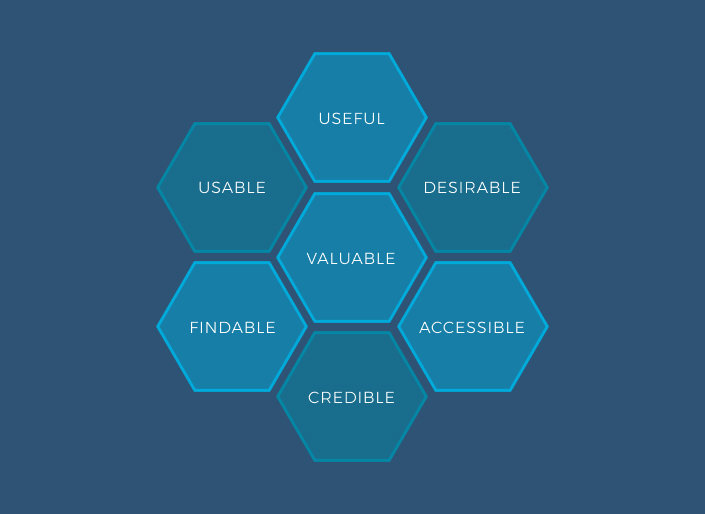User experience (UX) is a major force in closing a sale. Modern consumers aren’t satisfied with great products or services. They demand effortless transactions and excellent customer service from start to finish. As your business’ digital home, your website must meet these expectations right from the landing page and across all touchpoints.
According to a study by Forrester, investing in UX gives an ROI of 9,900%. That is, for every dollar that goes into improving your customers’ online journey, you can expect $100 in return. Of course, getting a return on investment requires significant enhancements to your website.
What Makes an Effective User Experience?
Valuable user experience is defined by a number of facets — all working together to provide patrons a memorable interaction with your brand. Peter Morville, the founding father of information architecture, illustrated this through the User Experience Honeycomb.

The User Experience Honeycomb formulated by Peter Morville
As Morville explained, effective user experience is achieved when e-commerce websites are:
- Usable – good websites are user-friendly. This facet is vital, but not sufficient.
- Useful – cater to the needs of a customer and continuously be on the lookout for opportunities to be more efficient.
- Desirable – customers are reeled in when the site is aesthetically pleasing. Apply the elements of emotional design in the image, identity, and branding of your business.
- Accessible – make information accessible even to people with disabilities.
- Findable – ensure that the website is easily navigable and that pertinent information is conspicuously located.
- Credible – communicate that your business is trustworthy through web design.
Combining these facets boils down to three key elements: design, content, and code.
The Impact of Visual Design on User Experience
The first interaction your business will have with a customer is visual. Your logo, color palette, and overall aesthetic speak volumes at a single glance. Because we are hard-wired for visual input, it takes only 50 milliseconds for a user to decide what he or she thinks of your brand.
The design of your website also influences attitudes past first impressions. Good visuals strengthen the bond between your business and the user. With the proper use of lines, colors, spacing, and other elements, you can communicate credibility as well as express your brand values.
That is why a beautiful digital design is imperative. When your website appeals to users on a visceral level, you gain more traffic, lower bounce rate, and encourage customers to spend more time on your site.
This attractiveness bias also increases people’s tolerance for usability issues, known as the aesthetic-usability effect. Visually-pleasing designs make users perceive interfaces to be more intuitive, regardless of whether or not they are truly easier to navigate than less attractive alternatives.
User Interface vs. User Experience
User interface (UI) and UX are often mentioned side-by-side, if not interchanged. Although the two concepts are related, they are not the same. UX is the interaction users have with your brand, while UI is the platform that enables interactions to occur.
UI design also involves aesthetics but is mainly concerned with optimizing for responsiveness, efficiency, and accessibility. Its goal is to display products or services logically so that users are enticed to keep exploring your site.

Aside from visual design, UI is anchored on interactive design and information architecture. Web designers anticipate users’ preferences when navigating a website and use them as a guide.
Balancing Aesthetic Appeal and Functionality
While a visually attractive website gives you a headstart, functionality remains a major concern in UX design. Slow-loading websites cost business owners two billion dollars annually due to a loss in sales.
Striking a balance between visual appeal and usability is vital in delivering a fulfilling user experience. To do this, you have to think of and use aesthetics as a tool rather than decoration. This way, visual design is integrated with UI design seamlessly.
Opting for a simple navigation menu, for example, ensures you don’t leave buyers confused and frustrated. In turn, an effective UI design helps improve your conversion rate by up to 200%. What’s more, it promotes traffic and encourages users to stay loyal to your brand.
The Value of Content in User Experience
At the heart of UX design is quality content. Users are brought to your website because they want information. No matter how attractive or functional a website is, if it lacks relevant content, users will most likely hate the experience. In fact, 79% of visitors exit a website with unoptimized content to search again.

The right words draw users in and drive engagement. They set the tone for your brand and provide the necessary context to evoke emotions and resonance. Content allows you to tell your story and make the user’s experience feel more personalized and conversational.
Landing page designs that incorporate positive trigger words increase the likelihood of converting visitors to paying customers. These include ‘order’, ‘cheapest’, ‘best’, discount’, and ‘fast’. Similarly, product pages with spot-on descriptions compel users to make a transaction.
The Importance of Code in UX Design
UX design is brought to life not just by creatives but also by web developers. Front-end developers are responsible for materializing blueprints using Javascript, CSS, or HTML code. On the other hand, back-end developers work on the server-side of a website or application.
Whereas front-end developers spend their time laying out content and media on a website, back-end developers are concerned with logic, data, and debugging. Both kinds of website developers are crucial in executing UX design.
Without skilled web developers, UX designs may not be fully realized, barring you from reaping all its benefits. You may end up with an oversimplified aesthetic or slow pages rife with glitches.
Looking to enhance your customers’ user experience? Get in touch with DevWerkz to work with a team of professional web developers and designers at a winning price.